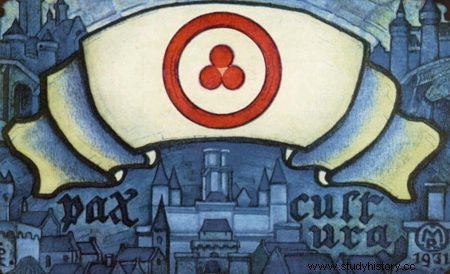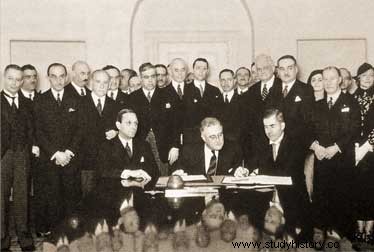With our contemporary glasses, peace and heritage preservation initiatives may seem trivial to us on the threshold of the Second World War. And yet, before this 20th century completely consumed men and stones, certain individuals were struggling to save the buildings and the knowledge that flowed from them, and this in an omnipresent tension on the globe. But before talking about the pact, let's talk about the inspirer; who is he and where does he come from?
Born in Saint Petersburg in 1874, the Russian painter Nicholas Roerich is the initiator of the first treaty in world history on the protection of the cultural heritage of humanity in the broadest and even, one would say, global sense of this concept. The Roerich Pact protects churches, mosques and cathedrals, museums and libraries, schools and universities, theaters and scientific institutions, pyramids and ancient temples – in short, everything dedicated to art, education, science and religion.

(1) Nicholas Roerich around 1940.
It should be noted all the same that the principle of heritage conservation and protection was not a totally new inspiration when it was signed in 1935. The Hague conferences of 1899 (the very first, on the initiative of Nicolas II of Russia) and the next, that of 1907, were already aimed at protecting heritage.
As a painter, archaeologist and historical researcher, Nicholas Roerich experienced most deeply the tragedy of the destruction of cultural values. He spoke of peace, creating the famous Roerich Pact and the Banner of Peace. Before serious disasters befall humanity – notably from two world wars, he warned of a Third World catastrophe. He sent messages of peace to all parts of the globe to clear space, to aid in the growth of human consciousness.
Nicholas Roerich expressed his idea of the great need to protect cultural monuments for the benefit of all mankind in 1904, after returning from a trip to several Russian cities. However Roerich did not succeed in implementing his plan until 1930, when the Committee of Museums of the League of Nations unanimously decided to support the Covenant and the Banner of Peace.
The main objective of his plan is to protect the values of culture, art and science of the whole world from destruction, which manifests itself not only during war, but also in times of peace. According to the Roerich Pact, all museums, cathedrals, libraries, universities, monuments, public and private art and scientific collections, natural monuments, beautiful places should be considered neutral objects and as such should be protected and respected by states that have acceded to the treaty.
In order to designate cultural monuments as neutral objects, according to Roerich's sketch, the Banner of Peace was created, which was to be hoisted above protected cultural institutions.

(2) Banner of Peace, established in Washington, April 15, 1935. It will be changed in 1954 during the Hague Convention.
Nicholas Roerich accompanied his project with these words:
“It is imperative to take immediate action to protect the noble heritage of the past for the glorious future from danger. This will happen when all countries solemnly pledge to protect the treasures of culture, which in essence do not belong to one people, but to the world. In this way, we can create another approach to the flourishing of culture and peace. “
In 1931-1932, two representative international conferences of the International Peace Pact were held in Bruges (Belgium), the aim of which was the universal ratification of the proposed pact. Eminent public figures, scientists, writers and artists have joined the ideas to promote this project. Romain Rolland and Bernard Shaw, Rabindranath Tagore and Thomas Mann, Albert Einstein and HG Wells supported the Pact. Committees were created in America and Europe, actively supporting the idea of protecting the culture of all countries. And finally, on April 15, 1935, a solemn program of ratification by the United States and the twenty-one Latin American republics of the Pact and the Banner of Peace took place at the White House, in Washington. President Roosevelt gave a speech on international radio about the meaning of the peace pact.

(3) Signing of the Roerich Pact on April 15, 1935. Center:US President F. Roosevelt.
Roerich's pact is still currently in effect.
Sources and references.
The illustration of the article is a painting by Roerich – 1901.
Biography of Roerich
Britannica
